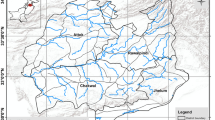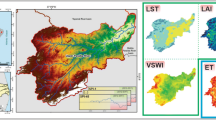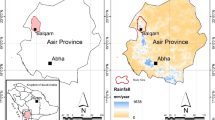Abstract
Droughts have significant negative impacts on livelihoods and economy of Kazakhstan. In this study, we assessed and characterized drought hazard events in Kazakhstan using satellite Remote Sensing time series for the period between 2000 and 2016. First, we calculated Vegetation Condition Index (VCI) and Standardized Enhanced Vegetation Index anomalies (ZEVI) based on 250 m Moderate Resolution Imaging Spectroradiometer (MODIS) Enhanced Vegetation Index (EVI) time series. Second, we assessed vegetation cover changes for the observation period. Third, we analyzed different characteristics of the drought hazard as well as spatial distribution of the drought-affected areas within the country. The results confirmed that drought was one of the environmental challenges for Kazakhstan in 2000–2016. The obtained maps showed that drought hazard conditions were observed every year, though the areal coverage of the drought conditions largely varied between the analyzed years. The calculated drought indices indicated that in years 2000, 2008, 2010, 2011, 2012, and 2014, more than 50% of the area of the country were affected by drought conditions of different severity with the largest droughts in terms of the areal spread occurring in 2012 and 2014. We concluded that the pre-requisite of successful implementation of drought hazard and risk mitigation strategies is availability of spatially explicit, timely, and reliable information on drought hazard. This suggests the necessity of incorporation of remote sensing–based drought information, as was demonstrated in this paper, in the national drought monitoring system of Kazakhstan.









Similar content being viewed by others
References
Anyamba, A., & Tucker, C. J. (2005). Analysis of Sahelian vegetation dynamics using NOAA-AVHRR NDVI data from 1981–2003. Journal of Arid Environments, 63, 596–614. https://doi.org/10.1016/j.jaridenv.2005.03.007.
Aw-Hassan, A., Korol, V., Nishanov, N., Djanibekov, U., Dubovyk, O., & Mirzabaev, A. (2016). Economics of Land Degradation and Improvement in Uzbekistan. In Economics of land degradation and improvement – a global assessment for sustainable development (pp. 651–682). Cham: Springer.
Barrett, T., Feola, G., Khusnitdinova, M., & Krylova, V. (2017). Adapting agricultural water use to climate change in a post-soviet context: challenges and opportunities in Southeast Kazakhstan. Human Ecology, 45, 747–762. https://doi.org/10.1007/s10745-017-9947-9.
Beguería, S., Vicente-Serrano, S. M., Reig, F., & Latorre, B. (2014). Standardized precipitation evapotranspiration index (SPEI) revisited: parameter fitting, evapotranspiration models, tools, datasets and drought monitoring. International Journal of Climatology, 34, 3001–3023.
Below, R., Grover-Kopec, E., & Dilley, M. (2007). Documenting drought-related disasters: a global reassessment. Journal of Environment & Development, 16, 328–344. https://doi.org/10.1177/1070496507306222.
de Beurs, K. M., Henebry, G. M., Owsley, B. C., & Sokolik, I. (2015). Using multiple remote sensing perspectives to identify and attribute land surface dynamics in Central Asia 2001–2013. Remote Sensing of Environment, 170, 48–61. https://doi.org/10.1016/j.rse.2015.08.018.
Bhuiyan, C., Singh, R. P., & Kogan, F. N. (2006). Monitoring drought dynamics in the Aravalli region (India) using different indices based on ground and remote sensing data. International Journal of Applied Earth Observation and Geoinformation, 8, 289–302. https://doi.org/10.1016/j.jag.2006.03.002.
Bokusheva, R., Kogan, F., Vitkovskaya, I., Conradt, S., & Batyrbayeva, M. (2016). Satellite-based vegetation health indices as a criteria for insuring against drought-related yield losses. Agricultural and Forest Meteorology, 220, 200–206. https://doi.org/10.1016/j.agrformet.2015.12.066.
Broka, S., Giertz, Asa, Christensen, G., Rasmussen, D., Morgounov, A., Fileccia, T., Rubaiza, R.. (2016) Kazakhstan agricultural sector risk assessment
Carrao, H., Naumann, G., & Barbosa, P. (2016). Mapping global patterns of drought risk: an empirical framework based on sub-national estimates of hazard, exposure and vulnerability. Global Environmental Change, 39, 108–124.
Chen, X., Bai, J., Li, X., Luo, G., Li, J., & Li, B. L. (2013). Changes in land use/land cover and ecosystem services in Central Asia during 1990–2009. Current Opinion in Environment Sustainability, 5, 116–127. https://doi.org/10.1016/j.cosust.2012.12.005.
Dubovyk, O.. (2013) Multi-scale targeting of land degradation in northern Uzbekistan using satellite remote sensing
Dubovyk, O., Landmann, T., Dietz, A., & Menz, G. (2016). Quantifying the impacts of environmental factors on vegetation dynamics over climatic and management gradients of Central Asia. Remote Sensing, 8, 600. https://doi.org/10.3390/rs8070600.
Eisfelder, C., Klein, I., Niklaus, M., & Kuenzer, C. (2014). Net primary productivity in Kazakhstan, its spatio-temporal patterns and relation to meteorological variables. Journal of Arid Environments, 103, 17–30. https://doi.org/10.1016/j.jaridenv.2013.12.005.
Esekin, B.K.. (2000) Kazakhstan, State of the environment. Natl. Environ. Cent. Sustain. Dev. Repub. Kazakhstan
FAO, The World Bank. (2019) understanding the drought impact of El Niño/La Niña in the grain production areas in Eastern Europe and Central Asia: Russia, Ukraine and Kazakhstan., http://www.fao.org/3/ca3758en/ca3758en.pdf
Graw, V., Ghazaryan, G., Dall, K., Delgado Gómez, A., Abdel-Hamid, A., Jordaan, A., Piroska, R., Post, J., Szarzynski, J., Walz, Y., & Dubovyk, O. (2017). Drought dynamics and vegetation productivity in different land management systems of Eastern Cape, South Africa—a remote sensing perspective. Sustainability., 9, 1728. https://doi.org/10.3390/su9101728.
Gupta, S.C.. (2011) Fundamentals of statistics. Himalaya Publishing House.
Hamidov, A., Helming, K., & Balla, D. (2016). Impact of agricultural land use in Central Asia: a review. Agronomy for Sustainable Development, 36, 6. https://doi.org/10.1007/s13593-015-0337-7.
Hao, Z., Hao, F., Singh, V. P., Ouyang, W., & Cheng, H. (2017). An integrated package for drought monitoring, prediction and analysis to aid drought modeling and assessment. Environmental Modelling and Software, 91, 199–209. https://doi.org/10.1016/j.envsoft.2017.02.008.
Harris, I., Jones, P. D., Osborn, T. J., & Lister, D. H. (2014). Updated high-resolution grids of monthly climatic observations–the CRU TS3. 10 Dataset. International Journal of Climatology, 34, 623–642.
Hoaglin, D.C., Mosteller, F., Tukey, J.W.. (2000) Understanding robust and exploratory data analysis
Huang, A., Zhou, Y., Zhang, Y., Huang, D., Zhao, Y., & Wu, H. (2014). Changes of the annual precipitation over Central Asia in the twenty-first century projected by multimodels of CMIP5. Journal of Climate, 27, 6627–6646. https://doi.org/10.1175/JCLI-D-14-00070.1.
Jiang, L., Jiapaer, G., Bao, A., Guo, H., & Ndayisaba, F. (2017). Vegetation dynamics and responses to climate change and human activities in Central Asia. Science of the Total Environment, 599–600, 967–980. https://doi.org/10.1016/j.scitotenv.2017.05.012.
Kariyeva, J., van Leeuwen, W. J. D., & Woodhouse, C. A. (2012). Impacts of climate gradients on the vegetation phenology of major land use types in Central Asia (1981–2008). Frontiers in Earth Science, 6, 206–225. https://doi.org/10.1007/s11707-012-0315-1.
Kendall, M. G. (1938). A new measure of rank correlation. Biometrika., 30, 81–93.
Klein, I., Gessner, U., & Künzer, C. (2014). Generation of up to date land cover maps for Central Asia. In Novel measurement and assessment tools for monitoring and management of land and water resources in agricultural landscapes of Central Asia (pp. 329–346). Cham: Springer.
Kogan, F. N. (1990). Remote sensing of weather impacts on vegetation in non-homogeneous areas. International Journal of Remote Sensing, 11, 1405–1419. https://doi.org/10.1080/01431169008955102.
Kogan, F. N. (1995). Application of vegetation index and brightness temperature for drought detection. Advances in Space Research, 15, 91–100. https://doi.org/10.1016/0273-1177(95)00079-T.
Kogan, F. N. (1997). Global drought watch from space. Bulletin of the American Meteorological Society, 78, 621–636.
Kogan, F. (2002). World droughts in the new millennium from AVHRR-based vegetation health indices. EOS. Transactions of the American Geophysical Union, 83, 557–563. https://doi.org/10.1029/2002EO000382.
Kozhakhmetov, P., Zh., Nikiforova, L.N.. (2016) Weather elements of Kazakhstan in the context of global climate change, https://new.kazhydromet.kz/upload/pagefiles/nits/%D0%A3%D0%9A%D0%98%20%D0%9D%D0%98%D0%A6/eng/Climate%20Change_09-2017_ENG_Light.pdf
Kraemer, R., Prishchepov, A. V., Müller, D., Kuemmerle, T., Radeloff, V. C., Dara, A., Terekhov, A., & Frühauf, M. (2015). Long-term agricultural land-cover change and potential for cropland expansion in the former Virgin Lands area of Kazakhstan. Environmental Research Letters, 10, 054012. https://doi.org/10.1088/1748-9326/10/5/054012.
Kudebayeva, A., & Barrientos, A. (2017). A decade of poverty reduction in Kazakhstan 2001–2009: growth and/or redistribution? Journal of International Development, 29, 1166–1186.
Liefert, W., Liefert, O., Vocke, G., & Allen, E. (2010). Former Soviet Union region to play larger role in meeting world wheat needs. Amber Waves, 8, 12–19.
Lioubimtseva, E. (2015). A multi-scale assessment of human vulnerability to climate change in the Aral Sea basin. Environment and Earth Science, 73, 719–729. https://doi.org/10.1007/s12665-014-3104-1.
Lioubimtseva, E., & Cole, R. (2006). Uncertainties of climate change in arid environments of Central Asia. Reviews in Fisheries Science, 14, 29–49. https://doi.org/10.1080/10641260500340603.
Lioubimtseva, E., Cole, R., Adams, J. M., & Kapustin, G. (2005). Impacts of climate and land-cover changes in arid lands of Central Asia. Journal of Arid Environments, 62, 285–308. https://doi.org/10.1016/j.jaridenv.2004.11.005.
Liouimtseva, E.. (2009) Human dimensions of climate change in arid and semi-arid environments: a case study of post-Soviet Central Asia
Löw, F., Fliemann, E., Abdullaev, I., Conrad, C., & Lamers, J. P. A. (2015). Mapping abandoned agricultural land in Kyzyl-Orda, Kazakhstan using satellite remote sensing. Applied Geography, 62, 377–390. https://doi.org/10.1016/j.apgeog.2015.05.009.
Löw, F., Biradar, C., Dubovyk, O., Fliemann, E., Akramkhanov, A., Vallejo, A. N., & Waldner, F. (2017). Regional-scale monitoring of cropland intensity and productivity with multi-source satellite image time series. GIScience & Remote Sensing, 55, 539–567. 0, 1–29. https://doi.org/10.1080/15481603.2017.1414010.
Lu, L., Guo, H., Kuenzer, C., Klein, I., Zhang, L., & Li, X. (2014). Analyzing phenological changes with remote sensing data in Central Asia. IOP Conference Series: Earth and Environmental Science, 17, 012005. https://doi.org/10.1088/1755-1315/17/1/012005.
Mann, H. B. (1945). Nonparametric tests against trend. Econometrica:Journal of Economic and Social, 13, 245–259.
Martínez-Fernández, J., González-Zamora, A., Sánchez, N., Gumuzzio, A., & Herrero-Jiménez, C. M. (2016). Satellite soil moisture for agricultural drought monitoring: assessment of the SMOS derived Soil Water Deficit Index. Remote Sensing of Environment, 177, 277–286. https://doi.org/10.1016/j.rse.2016.02.064.
McKee, T. B., Doesken, N. J., & Kleist, J. (1993). The relationship of drought frequency and duration to time scales. In Proceedings of the 8th Conference on Applied Climatology (pp. 179–183). MA: American Meteorological Society Boston.
Meyfroidt, P., Schierhorn, F., Prishchepov, A. V., Müller, D., & Kuemmerle, T. (2016). Drivers, constraints and trade-offs associated with recultivating abandoned cropland in Russia, Ukraine and Kazakhstan. Global Environmental Change, 37, 1–15. https://doi.org/10.1016/j.gloenvcha.2016.01.003.
Ministry of Energy of the Republic of Kazakhstan Republican state enterprise “Kazhydromet”, (2015) Annual bulletin on climate change and climate monitoring in Kazakhstan, https://kazhydromet.kz/upload/pdf/climat/en_1495436641.pdf, (2016)
Mirzabaev, A., Goedecke, J., Dubovyk, O., Djanibekov, U., Le, Q. B., & Aw-Hassan, A. (2016). Economics of land degradation in Central Asia. In Economics of land degradation and improvement – a global assessment for sustainable development (pp. 261–290). Cham: Springer.
National Drought Mitigation Center, (2008) Food and Agriculture Organization: The Near East Drought Planning Manual
Neeti, N., & Eastman, J. R. (2011). A contextual Mann-Kendall approach for the assessment of trend significance in image time series. Transactions in GIS, 15, 599–611. https://doi.org/10.1111/j.1467-9671.2011.01280.x.
Parkinson, C.L., Greenstone, R., Closs, J.. (2000) EOS data products handbook. Volume 2
Parmentier, B., & Eastman, J. R. (2014). Land transitions from multivariate time series: using seasonal trend analysis and segmentation to detect land-cover changes. International Journal of Remote Sensing, 35, 671–692. https://doi.org/10.1080/01431161.2013.871595.
Prishchepov, A. V., Radeloff, V. C., Baumann, M., Kuemmerle, T., & Müller, D. (2012). Effects of institutional changes on land use: agricultural land abandonment during the transition from state-command to market-driven economies in post-Soviet Eastern Europe. Environmental Research Letters, 7, 024021. https://doi.org/10.1088/1748-9326/7/2/024021.
Propastin, P.A., Kappas, M., Muratova, N.R.. (2008) Inter-annual changes in vegetation activities and their relationship to temperature and precipitation in Central Asia from 1982 to 2003. Journal of Environmental Informatics 12
Quiring, S. M., & Ganesh, S. (2010). Evaluating the utility of the Vegetation Condition Index (VCI) for monitoring meteorological drought in Texas. Agricultural and Forest Meteorology, 150, 330–339. https://doi.org/10.1016/j.agrformet.2009.11.015.
Republican State Enterprise “Kazhydromet”. (2015) 6. Assessment report on climate change in Kazakhstan
Rojas, O., Piersante, A., Cumani, M., Li, Y.. (2019) Understanding the drought impact of El Niño/La Niña in the grain production areas in Eastern Europe and Central Asia. World Bank Publ
Sen, P. K. (1968). Estimates of the regression coefficient based on Kendall’s Tau. Journal of the American Statistical Association, 63, 1379–1389. https://doi.org/10.1080/01621459.1968.10480934.
Siebert, S., Webber, H., & Rezaei, E. E. (2017). Weather impacts on crop yields-searching for simple answers to a complex problem. Environmental Research Letters, 12, 081001.
Theil, H. (1992). A rank-invariant method of linear and polynomial regression analysis. In Henri Theil’s contributions to economics and econometrics (pp. 345–381). Dordrecht: Springer.
Unganai, L. S., & Kogan, F. N. (1998). Drought monitoring and corn yield estimation in Southern Africa from AVHRR Data. Remote Sensing of Environment, 63, 219–232. https://doi.org/10.1016/S0034-4257(97)00132-6.
Van Hoolst, R., Eerens, H., Haesen, D., Royer, A., Bydekerke, L., Rojas, O., Li, Y., & Racionzer, P. (2016). FAO’s AVHRR-based Agricultural Stress Index System (ASIS) for global drought monitoring. International Journal of Remote Sensing, 37, 418–439.
Vermote, E. F., El Saleous, N. Z., & Justice, C. O. (2002). Atmospheric correction of MODIS data in the visible to middle infrared: first results. Remote Sensing of Environment, 83, 97–111.
Vicente-Serrano, S., Beguería, S., Latorre, B., Reig, F.. (2019) SPEI, the Standardised Precipitation-Evapotranspiration Index, https://spei.csic.es/
Wilhite, D. A., & Glantz, M. H. (1985). Understanding: the drought phenomenon: the role of definitions. Water International, 10, 111–120.
World Bank. (2005) Drought : management and mitigation assessment for Central Asia and the Caucasus (English), http://documents.worldbank.org/curated/en/135721468036310201/Drought-management-and-mitigation-assessment-for-Central-Asia-and-the-Caucasus
World Bank. (2006) Drought management and mitigation assessment for Central Asia and the Caucasus: regional and country profiles and strategies, http://siteresources.worldbank.org/INTECAREGTOPRURDEV/Resources/CentralAsiaCaucasusDroughtProfiles&Strategies-Eng.pdf
Wu, J., Zhou, L., Mo, X., Zhou, H., Zhang, J., & Jia, R. (2015). Drought monitoring and analysis in China based on the Integrated Surface Drought Index (ISDI). International Journal of Applied Earth Observation and Geoinformation, 41, 23–33. https://doi.org/10.1016/j.jag.2015.04.006.
Xu, L., Zhou, H., Du, L., Yao, H., & Wang, H. (2015). Precipitation trends and variability from 1950 to 2000 in arid lands of Central Asia. Journal of Arid Land, 7, 514–526. https://doi.org/10.1007/s40333-015-0045-9.
Xu, H., Wang, X., & Zhang, X. (2016). Decreased vegetation growth in response to summer drought in Central Asia from 2000 to 2012. International Journal of Applied Earth Observation and Geoinformation, 52, 390–402. https://doi.org/10.1016/j.jag.2016.07.010.
Zambrano, F., Lillo-Saavedra, M., Verbist, K., & Lagos, O. (2016). Sixteen years of agricultural drought assessment of the BioBío region in Chile Using a 250 m Resolution Vegetation Condition Index (VCI). Remote Sensing, 8, 530. https://doi.org/10.3390/rs8060530.
Zhang, A., & Jia, G. (2013). Monitoring meteorological drought in semiarid regions using multi-sensor microwave remote sensing data. Remote Sensing of Environment, 134, 12–23. https://doi.org/10.1016/j.rse.2013.02.023.
Zhang, L., Jiao, W., Zhang, H., Huang, C., & Tong, Q. (2017a). Studying drought phenomena in the Continental United States in 2011 and 2012 using various drought indices. Remote Sensing of Environment, 190, 96–106. https://doi.org/10.1016/j.rse.2016.12.010.
Zhang, X., Chen, N., Li, J., Chen, Z., & Niyogi, D. (2017b). Multi-sensor integrated framework and index for agricultural drought monitoring. Remote Sensing of Environment, 188, 141–163. https://doi.org/10.1016/j.rse.2016.10.045.
Zhou, Y., Zhang, L., Fensholt, R., Wang, K., Vitkovskaya, I., & Tian, F. (2015). Climate contributions to vegetation variations in Central Asian Drylands: pre- and post-USSR collapse. Remote Sensing, 7, 2449–2470. https://doi.org/10.3390/rs70302449.
Funding
The research support was provided by the German Federal Ministry of Education and Research (Project: GlobeDrought, grant no. 02WGR1457F BMBF Project ID: 02WGR1457A-F).
Author information
Authors and Affiliations
Corresponding author
Additional information
Publisher’s note
Springer Nature remains neutral with regard to jurisdictional claims in published maps and institutional affiliations.
Rights and permissions
About this article
Cite this article
Dubovyk, O., Ghazaryan, G., González, J. et al. Drought hazard in Kazakhstan in 2000–2016: a remote sensing perspective. Environ Monit Assess 191, 510 (2019). https://doi.org/10.1007/s10661-019-7620-z
Received:
Accepted:
Published:
DOI: https://doi.org/10.1007/s10661-019-7620-z




